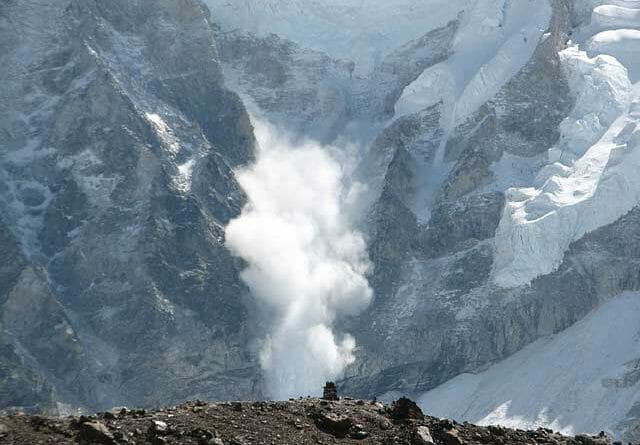What causes avalanches? An experiment!
Overview: A common demonstration of snow stability and instability (why avalanches happen) involves layering different materials such as flour and sugar onto a board until a “break point” is reached. In this lesson, students will design and conduct their own experiments to determine what conditions are most conducive to naturally triggered avalanches. They may also investigate how different types of terrain and slopes affect snowpack stability. As an added option, students may design experiments to investigate other avalanche triggers, such as human recreational activities.
Goals/Objectives:
Students will develop an understanding of avalanches as a natural hazard in alpine environments. They will gain knowledge about issues of snow stability in snowpacks. Students will also design and conduct avalanche experiments using flour, sugar, and other snow-simulating materials on a board.
Time Required: 5 hours
• 1/2 hour – avalanche article warm-up activity
• 1 hour – video
• 1 hour – background visual activity
• 1 hour – experiment design
• 1 hour – experiment time
• 1/2 hour – finish write-up
Materials:
• Avalanche video – many good videos about avalanches are available. Some examples include the following:
• Avalanche! (NOVA Video #WG2418N, 1997, 1 hr.) Check your local PBS station for broadcast times or order through www.wgbh.org. Associated lesson plans may be found on website.
• Avalanche (Discovery Channel, 1 hr.). Check for broadcast times on Discovery Channel or order through Discovery Channel website.
• Violent Planet (National Geographic Explorer Series, Fall 1995, 25 mins.). Order by calling 1-800-647-5463.
• Plywood boards (or similar…foam core boards, cardboard; anything that will be a flat surface that can both support the snow and surface simulation materials and be placed at different slope angles)
• Compass to measure slope angles tested
• Plastic tarp or newspapers (to keep mess to a minimum!)
• “Snow” materials: Flour, Sugar, Mashed potato flakes, and other substances that
would simulate different snow characteristics.
• “rocks” and other materials that might simulate other surfaces
• glue or similar adhesive
• sifter
Procedure:
1. Avalanche Article Warm-Up Activity: Understanding Avalanche Hazards – Give students an article to read about a recent avalanche event and resulting deaths or injuries. Many such articles may be found at Ask them to answer/discuss, written or orally, what caused the event.
2. Show a video about avalanches
Discuss with the students any physical processes of snowfall and snowpack development that occur in alpine environments that are shown in the video. Also, discuss the conditions that are conducive to avalanche hazards and avalanche triggering mechanisms.
3. Background/Visual Activity
• Terrain – Students will examine some photographs of the San Juan Mountains in Southwest Colorado to gain visual perspective of terrain that is conducive to avalanches. They should especially note the surface features (trees, rocks, avalanche chutes, etc.) and the steep slope angles of the mountains.
• Snowpack stratigraphy – Students will use knowledge gained from video to discuss snowpack characteristics/stratigraphy in terms of weak and strong layers.
4. Experiment Design
Next, have the students design an avalanche experiment. They will be able to use the materials listed to conduct the experiment. Have the students identify a testable question and design the experiment, identifying dependent and independent variables and factors for which they will control. Before beginning the experiment, the students should begin their lab write-up, including the following components:
1. Testable question
2. Hypothesis
3. Materials
4. Procedure
5. Data Table
Some possible experiment categories are listed below:
• Design experiments to test snow stratigraphy characteristics for avalanches. What kinds of “snow” are stable or unstable?
• Experiment with slope; what slopes (in degrees) are most or least conducive to avalanches?
• Experiment with terrain; what types of terrain aid or inhibit the occurrence of avalanches?
• Experiment with avalanche triggering mechanisms; esp. weights and motion (animals, skiers, snowmobiles, etc).
• Other avalanche triggers can be tested, especially human triggers. For example, use remote-controlled vehicles to simulate snowmobiles or weights/popsicle sticks to simulate skiers.
5. Conducting the Experiments
When the students are ready to conduct their experiments, make sure they cover the testing area with a tarp or newspapers to facilitate cleanup. This can be a very messy experiment!
The students should collect data as they experiment and write down the results.
6. Write-Up
To complete the lab write-up, students should ensure that their data are organized, write a section for data analysis and a final conclusion section. Students should evaluate the model they created vs. the real world avalanche environment; how well does their
model represent the real world? What does their model take into account? What, if any, assumptions are made in the model? What would they change in their model?
Extensions:
Microscopes – have students examine their “snow crystals” under a compound microscope and draw & label the shapes of the “crystals”. For example, students could look at the shapes of sugar vs. flour under a microscope to determine which might form weak or strong layers in their simulated snowpack.
Topographic Maps – Students can examine avalanche terrain slopes on topographic maps. For more information about topographic maps, see
Online modules:
• Interactive Backcountry Tour
• A Day in the Backcountry (24 slides)
Closure:
To complete the lab write-up, students should ensure that their data are organized, write a section for data analysis and a final conclusion section. Students should evaluate the model they created vs. the real world avalanche environment; how well does their model represent the real world? What does their model take into account? What, if any, assumptions are made in the model? What would they change in their model?
Authors: Colleen Garrity (Arizona State University GK12 Fellow)
Anne English, Patrick Dwyer (Desert Eagle Secondary School Science Teachers)

